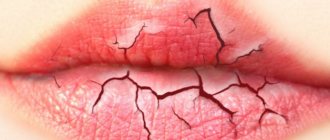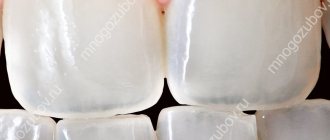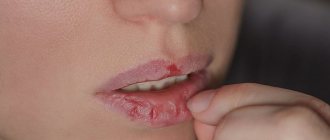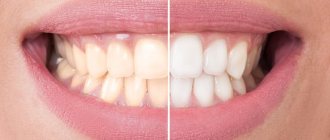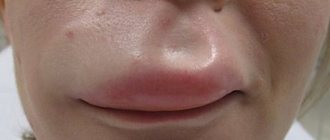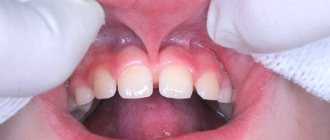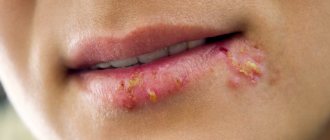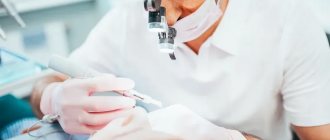Lips have the same thin skin as the area around the eyes - so their appearance quickly reveals age. We know that lips lose their previous volume and become thinner over time. What about color loss? It turns out that this process often also signals us about age-related changes in the body.
View on Instagram
What it is
Cheilitis on the lips is a common phenomenon, however, most patients do not even suspect that damage to the mucous membrane and skin of the lips is a serious pathology.
Cheilitis is a disease associated with an inflammatory process that affects not only the mucous membrane, but also the red border of the lips. In addition, cheilitis is any abnormal change in the epithelial layer of the lips that occurs against the background of a serious disease of the internal organs or a sharp drop in immunity.
The location of the damaged areas may not be limited only to inflammation of the lip. In addition to dislocation on the upper and lower lip, as well as in the corners of the mouth (the so-called “angular cheilitis”), similar foci of inflammation can appear anywhere on the body, especially on the mucous membranes. The problem of damage specifically to the lip area is due to the fact that they are deprived of a protective layer, while they are constantly exposed to external negative influences, leading to overdrying, the formation of microcracks, and infections.
How to stop it
As we said above, as we age, lips lose pigment for the same reasons they can become thinner—with the loss of collagen and moisture, they appear less vibrant. It's a natural part of aging, but there are a few ways to make sure you're not speeding up the process:
- Maintain normal collagen Supplements can protect your cells' fibroblasts, which are involved in creating collagen and elastin. Studies have shown that they maintain skin elasticity and density.
- Protect your lips from ultraviolet radiation . Products with SPF (look for titanium dioxide and zinc oxide) are equally necessary for both facial skin and lips - they prevent their thinning and fading.
- Keep them hydrated. Chapped lips will never look bright, which is why you should take special care to care for them in three stages - exfoliating, moisturizing and nourishing. In summer, you can get by with balms and oils: remember that the skin becomes more permeable at night. And in aggressive winter conditions it is better to resort to injections of hyaluronic acid.
Hydrolyzed marine collagen, hyaluronic acid and vitamin C, CollagenUP, California Gold Nutrition, 1343 rubles
Sunscreen lip gloss UV Lip Color Splash, Shiseido, 2300 rubles
Cream for the eye area and lip contour Orchidée Impériale, Guerlain, 13,070 rubles
Reasons for education
The causes of damage to the mucous membrane of the lips are the harmful effects of the environment, sudden changes in temperature in winter and summer, leading to chapping, drying out and the formation of cracks. Excessive intake of spicy, hot, salty and sour foods can also cause inflammation. In addition, the following reasons contribute to the formation of cheilitis:
- Clogging of pores with lanolin (animal wool wax found in lipsticks), leading to flaking, irritation and allergic reactions.
- Contact allergies and dermatoses that occur when lips come into contact with harmful chemical compounds (at work or just in everyday life).
- Systemic diseases of the endocrine system, congenital and acquired immunodeficiencies.
- Lip lesions can also be caused by such serious diseases as skin tuberculosis, lichen, and syphilis.
- Diseases that arise from the nervous system, such as psoriasis and eczema, can also cause complications in the lip area.
- There are also possible genetic causes of cheilitis, for example, with ichthyosis.
- Diseases of internal organs can affect the development of the inflammatory process. There are frequent cases of lip damage due to the liver or disruptions in the gastrointestinal tract.
- A sharp decrease in the level of body resistance due to cancer or its treatment (during chemotherapy) also leads to a disruption of the natural protection of the lip area.
Why are lips white
Human lips, their surface, mucous membrane, and surrounding skin very often display pathological changes that fall within the scope of consideration of several areas of medicine. As a rule, these are deviations that require dermatological, dental, therapeutic care, and the attention of infectious disease doctors.
Only a qualified specialist will be able to determine whether, in your case, white lips are an external sign of illness or a temporary cosmetic problem.
The main reasons why a person’s lips turn white are as follows.
- Manifestation of anemia. The lips and their mucous membranes lose their natural color and turn white due to a decrease in hemoglobin content in the blood. Such changes are observed mainly in iron deficiency or anemia caused by a lack of vitamin B12. The change in color is often accompanied by a deterioration in general health, headaches, burning and painful sensations in the lips, and their dryness.
- Oral candidiasis. More common in young children. It develops when infected with yeast-like fungi of the genus Candida. First, white dotted spots appear on the lips, later they merge and form a continuous film.
- Leukoplakia. A chronic disease accompanied by increased keratinization of the epithelium and inflammation of the mucous membrane. The color of the lesions on the lips can vary, including whitish or white-gray.
- Smoking. Under the influence of nicotine, foci of whitish hyperkeratosis may appear.
- The influence of meteorological conditions (dry air, wind, low temperatures). In such situations, a short-term change in color is observed, followed by restoration of normal tone when the provoking factor is eliminated.
If the natural color of the lips is not restored within several days, they are sore, there are rashes on the surface, or a deterioration in the general condition, you need to consult a doctor - a therapist or a dermatologist. He will study your complaints, conduct anamnestic information collection and a physical examination. If there is a suspicion of a systemic or infectious disease, he will refer a specialist of the appropriate profile for consultation.
Symptoms
There are several different types of lip inflammation, each of which has individual signs and symptoms. If we take the general picture of cheilitis, the symptoms characteristic of all types are as follows:
- Most often, patients complain of dryness, burning and flaking of the skin of the lips;
- with some types of cheilitis, small painful blisters, ulcers and cracks may appear;
- the standard location of inflammation is limited to the mucous membrane and red border of the lips, but in some cases it can spread to surrounding tissues;
- with systemic diseases, painful plaques and purulent discharge may appear on the lips.
In the case of allergic reactions, the inflammatory process can last for several months in a row, however, if the inflammation does not go away for more than six months, there is a reason to get tested and look for the cause of cheilitis in other diseases. The risk of the inflammatory process transforming into a malignant tumor cannot be excluded.
Homeopathic medicines
Homeopathy will help eliminate the unpleasant symptoms manifested in pale skin. Homeopathic medicines for the symptomatic treatment of pale lips act on the cause that caused the symptom:
- Calendula (Calendula) – eliminates the consequences of aggressive environmental influences;
- Bryonia (Bryonia) – prescribed for dry mouth;
- Calcium phosphoricum (Calcium phosphoricum) – for candidiasis, leukoplakia, dental problems;
- Arsenicum album (Arsenicum album) – for heart problems accompanied by a feeling of pressure in the chest; works as a short-term cardiac stimulant;
- Antimonium tartaricum (Antimonium tartaricum) - helps with plaque in the mouth, with a feeling of emptiness in the chest in adult patients with heart problems;
- Carbo vegetabilis (Carbo vegetabilis) - for heart problems, cyanosis, accompanied by pale skin; also for gastrointestinal diseases;
- Oxalicum acidum (Oxalicum acidum) - in case of cyanosis on the face in adults;
- Arnica montana (Arnica) – for physical weakness with anemia, pallor of the skin;
- Hamamelis (Witch hazel) – from anemic symptoms after the flu, blood loss, diarrhea, also helps with a tendency to bleeding;
- Ferrum phosphoricum (Ferrum phosphoricum) - from weakness caused by anemia, with exhaustion of the body, loss of strength caused by this disease of various etiologies.
Treatment
Cheilitis requires specific treatment depending on the type and cause of its formation. Many people faced with this problem have a reasonable question about which doctor treats cheilitis. Oddly enough, you need to see a dentist.
The most commonly prescribed treatments are zinc ointment, hydrocortisone, prednisolone ointment or solcoseryl for allergic manifestations and mild damage to the epithelial layer. Depending on the complexity of the situation and the external manifestations of the disease, the doctor will explain to you how to smear the lesions and with what frequency so that they heal faster.
Some types of cheilitis on the lips require only local treatment, which consists of eliminating external causes of the disease and damage to the mucous membrane and skin of the lips. In others, complete sanitation of the oral cavity and careful treatment of diseased areas with oil solutions of vitamins are necessary. In addition, your doctor may advise you to frequently rinse your mouth with anti-inflammatory and wound-healing agents such as chamomile, oak bark, and calendula.
More serious medications are prescribed only for severe lesions and the need to treat the primary disease that caused the inflammatory process. There are also cases when surgical intervention is indicated.
Is cheilitis contagious? If we are not talking about a viral cause of the development of inflammation on the lips, there is nothing to fear, since external manifestations are only a consequence of internal problems in the body.
White lips in adults and children: diagnosis and treatment
In cases where anamnesis and visual examination of the affected areas of the lips are not enough to make an accurate diagnosis, laboratory and instrumental studies are prescribed. Usually this:
- clinical blood and urine analysis;
- blood chemistry;
- microscopy of lip plaque, histological examination of the selected material;
- Ultrasound, CT, MRI - if necessary, assess the condition of internal organs.
After the diagnosis is made, measures are taken to eliminate the causes of the disease. For some, the doctor will recommend getting rid of bad habits, preventing the adverse effects of the environment, and reviewing their diet in order to saturate it with vitamins and microelements. Others will need drug therapy with systemic and local medications. The choice of medications is carried out taking into account the characteristics of pathological changes in the lips and the nature of the body diseases identified during diagnosis.
What color of the labia is considered normal?
The concept of normal for the color of the labia is very relative. For example, among Europeans, Americans and Scandinavians, red labia prevail, with varying degrees of saturation, from pale to bright pink or brick red. Asians and women from the African region most often have brown labia, ranging from the lightest beige to dark, almost chocolate shades. In most cases, pigmentation is inherited and appears from generation to generation with minor changes.
In some cases, the color of the labia may be heterogeneous:
- different colors of the right and left labia;
- there is marbling (two or more colors mixed in the form of small specks);
- There is uneven coloring with a predominance of one color.
Such “spotting” is also considered normal, especially if the girl was born to parents from different racial groups. We can talk about pathology or deviation from the norm only if pigmentation changes throughout life.
How to make an appointment with a pediatrician
If the situation has become urgent, then you can dial an ambulance from our clinic, whose phone number is +7 (495) 229-00-03. You can also contact us through our website using the feedback form.
Our medical center staff act as quickly as possible. Especially if we are talking about an emergency situation that requires urgent hospitalization. The clinic carries out diagnostics and immediately prescribes the optimal treatment method that will help your child overcome all the difficulties of the disease as quickly as possible.
